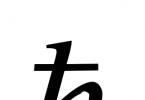CONTROL QUESTIONS
1) What is called deformation? What types of deformations do you know?
Deformation- a change in the relative position of body particles associated with their movement. Deformation is the result of changes in interatomic distances and rearrangement of blocks of atoms. Typically, deformation is accompanied by a change in the magnitude of interatomic forces, the measure of which is elastic stress.
Types of deformations:
Tension-compression- in the resistance of materials - a type of longitudinal deformation of a rod or beam that occurs if a load is applied to it along its longitudinal axis (the resultant of the forces acting on it is normal to the cross section of the rod and passes through its center of mass).
Tension causes elongation of the rod (rupture and residual deformation are also possible), compression causes shortening of the rod (loss of stability and longitudinal bending are possible).
Bend- a type of deformation in which there is a curvature of the axes of straight bars or a change in the curvature of the axes of curved bars. Bending is associated with the occurrence of bending moments in the cross sections of the beam. Direct bending occurs when the bending moment in a given cross-section of a beam acts in a plane passing through one of the main central axes of inertia of this section. In the case when the plane of action of the bending moment in a given cross section of the beam does not pass through any of the main axes of inertia of this section, it is called oblique.
If, during direct or oblique bending, only a bending moment acts in the cross section of the beam, then, accordingly, there is a pure straight or pure oblique bend. If a transverse force also acts in the cross section, then there is a transverse straight or transverse oblique bend.
Torsion- one of the types of body deformation. Occurs when a load is applied to a body in the form of a pair of forces (moment) in its transverse plane. In this case, only one internal force factor appears in the cross sections of the body - torque. Tension-compression springs and shafts work for torsion.
Types of deformation of a solid body. Deformation is elastic and plastic.
Deformation solid body can be a consequence of phase transformations associated with changes in volume, thermal expansion, magnetization (magnetostrictive effect), the appearance of an electric charge (piezoelectric effect) or the result of the action of external forces.
A deformation is called elastic if it disappears after the load that caused it is removed, and plastic if it does not disappear (at least completely) after the load is removed. All real solids, when deformed, have plastic properties to a greater or lesser extent. Under certain conditions, the plastic properties of bodies can be neglected, as is done in the theory of elasticity. With sufficient accuracy, a solid body can be considered elastic, that is, it does not exhibit noticeable plastic deformations until the load exceeds a certain limit.
The nature of plastic deformation can vary depending on temperature, duration of load or strain rate. With a constant load applied to the body, the deformation changes with time; this phenomenon is called creep. As temperature increases, the creep rate increases. Special cases of creep are relaxation and elastic aftereffect. One of the theories explaining the mechanism of plastic deformation is the theory of dislocations in crystals.
Derivation of Hooke's law for various types of deformation.
Net shift:
Pure torsion: ![]()
4) What is called the shear modulus and torsional modulus, what is their physical meaning?
Shear modulus or stiffness modulus (G or μ) characterizes the ability of a material to resist changes in shape while maintaining its volume; it is defined as the ratio of shear stress to shear strain, defined as the change in the right angle between the planes along which shear stresses act). The shear modulus is one of the components of the viscosity phenomenon.
Shear modulus:
Torsion modulus: 
5) What is the mathematical expression of Hooke's law? In what units are elastic modulus and stress measured?
Measured in Pa, - Hooke's law
The law of proportionality between the elongation of a spring and the applied force was discovered by the English physicist Robert Hooke (1635-1703)
Hooke's scientific interests were so broad that he often did not have time to complete his research. This gave rise to heated disputes about the priority in the discovery of certain laws with the greatest scientists (Huygens, Newton, etc.). However, Hooke's law was so convincingly substantiated by numerous experiments that Hooke's priority was never disputed.
Robert Hooke's spring theory:
This is Hooke's law!
PROBLEM SOLVING
Determine the stiffness of a spring that, under the action of a force of 10 N, lengthens by 5 cm.
Given:
g = 10 N/kg
F=10H
X = 5cm = 0.05m
Find:
k = ?

The load is in balance.

Answer: spring stiffness k = 200N/m.
TASK FOR "5"
(hand in on a piece of paper).
Explain why it is safe for an acrobat to jump onto a trampoline net from a great height? (we call on Robert Hooke for help)
I'm looking forward to your answer!
LITTLE EXPERIENCE
Place the rubber tube vertically, on which a metal ring has previously been tightly placed, and stretch the tube. What will happen to the ring?
Dynamics - Cool physics
DEFINITION
Deformations are any changes in the shape, size and volume of the body. Deformation determines the final result of the movement of body parts relative to each other.
DEFINITION
Elastic deformations are called deformations that completely disappear after the removal of external forces.
Plastic deformations are called deformations that remain fully or partially after the cessation of external forces.
The ability to elastic and plastic deformations depends on the nature of the substance of which the body is composed, the conditions in which it is located; methods of its manufacture. For example, if you take different types of iron or steel, you can find completely different elastic and plastic properties in them. At normal room temperatures, iron is a very soft, ductile material; hardened steel, on the contrary, is a hard, elastic material. The plasticity of many materials is a condition for their processing and for the manufacture of the necessary parts from them. Therefore, it is considered one of the most important technical properties of a solid.
When a solid body is deformed, particles (atoms, molecules or ions) are displaced from their original equilibrium positions to new positions. In this case, the force interactions between individual particles of the body change. As a result, internal forces arise in the deformed body, preventing its deformation.
There are tensile (compressive), shear, bending, and torsional deformations.
Elastic forces
DEFINITION
Elastic forces– these are the forces that arise in a body during its elastic deformation and are directed in the direction opposite to the displacement of particles during deformation.
Elastic forces are of an electromagnetic nature. They prevent deformations and are directed perpendicular to the contact surface of interacting bodies, and if bodies such as springs or threads interact, then the elastic forces are directed along their axis.
The elastic force acting on the body from the support is often called the support reaction force.
DEFINITION
Tensile strain (linear strain) is a deformation in which only one linear dimension of the body changes. Its quantitative characteristics are absolute and relative elongation.
Absolute elongation:
where and is the length of the body in the deformed and undeformed state, respectively.
Relative extension:
Hooke's law
Small and short-term deformations with a sufficient degree of accuracy can be considered as elastic. For such deformations, Hooke’s law is valid:
where is the projection of force onto the rigidity axis of the body, depending on the size of the body and the material from which it is made, the unit of rigidity in the SI system is N/m.
Examples of problem solving
EXAMPLE 1
| Exercise | A spring with stiffness N/m in an unloaded state has a length of 25 cm. What will be the length of the spring if a load weighing 2 kg is suspended from it? |
| Solution | Let's make a drawing.
An elastic force also acts on a load suspended on a spring. Projecting this vector equality onto the coordinate axis, we obtain: According to Hooke's law, elastic force: so we can write: where does the length of the deformed spring come from: Let us convert the length of the undeformed spring, cm, to the SI system. Substituting the numerical values of physical quantities into the formula, we calculate: |
| Answer | The length of the deformed spring will be 29 cm. |
EXAMPLE 2
| Exercise | A body weighing 3 kg is moved along a horizontal surface using a spring with stiffness N/m. How much will the spring lengthen if under its action, with uniformly accelerated motion, the speed of the body changes from 0 to 20 m/s in 10 s? Ignore friction. |
| Solution | Let's make a drawing.
The body is acted upon by the reaction force of the support and the elastic force of the spring. |
Hooke's law usually called linear relationships between strain components and stress components.
Let's take an elementary rectangular parallelepiped with faces parallel to the coordinate axes, loaded with normal stress σ x, evenly distributed over two opposite faces (Fig. 1). Wherein σy = σ z = τ x y = τ x z = τ yz = 0.
Up to the limit of proportionality, the relative elongation is given by the formula
Where E— tensile modulus of elasticity. For steel E = 2*10 5 MPa, therefore, the deformations are very small and are measured as a percentage or 1 * 10 5 (in strain gauge devices that measure deformations).
Extending an element in the axis direction X accompanied by its narrowing in the transverse direction, determined by the deformation components
Where μ - a constant called the lateral compression ratio or Poisson's ratio. For steel μ usually taken to be 0.25-0.3.
If the element in question is loaded simultaneously with normal stresses σx, σy, σ z, evenly distributed along its faces, then deformations are added

By superimposing the deformation components caused by each of the three stresses, we obtain the relations

These relationships are confirmed by numerous experiments. Applied overlay method or superpositions to find the total strains and stresses caused by several forces is legitimate as long as the strains and stresses are small and linearly dependent on the applied forces. In such cases, we neglect small changes in the dimensions of the deformed body and small movements of the points of application of external forces and base our calculations on the initial dimensions and initial shape of the body.

It should be noted that the smallness of the displacements does not necessarily mean that the relationships between forces and deformations are linear. So, for example, in a compressed force Q rod loaded additionally with shear force R, even with small deflection δ an additional point arises M = Qδ, which makes the problem nonlinear. In such cases, the total deflections are not linear functions of the forces and cannot be obtained by simple superposition.
It has been experimentally established that if shear stresses act along all faces of the element, then the distortion of the corresponding angle depends only on the corresponding components of the shear stress.
Constant G called the shear modulus of elasticity or shear modulus.
The general case of deformation of an element due to the action of three normal and three tangential stress components on it can be obtained using superposition: three shear deformations, determined by relations (5.2b), are superimposed on three linear deformations determined by expressions (5.2a). Equations (5.2a) and (5.2b) determine the relationship between the components of strains and stresses and are called generalized Hooke's law. Let us now show that the shear modulus G expressed in terms of tensile modulus of elasticity E and Poisson's ratio μ . To do this, consider the special case when σ x = σ , σy = -σ And σ z = 0.
Let's cut out the element abcd planes parallel to the axis z and inclined at an angle of 45° to the axes X And at(Fig. 3). As follows from the equilibrium conditions of element 0 bс, normal stress σ v on all faces of the element abcd are equal to zero, and the shear stresses are equal

This state of tension is called pure shear. From equations (5.2a) it follows that

that is, the extension of the horizontal element is 0 c equal to the shortening of the vertical element 0 b: εy = -εx.
Angle between faces ab And bc changes, and the corresponding shear strain value γ can be found from triangle 0 bс:

It follows that

Hooke's law was discovered in the 17th century by the Englishman Robert Hooke. This discovery about the stretching of a spring is one of the laws of elasticity theory and plays an important role in science and technology.
Definition and formula of Hooke's law
The formulation of this law is as follows: the elastic force that appears at the moment of deformation of a body is proportional to the elongation of the body and is directed opposite to the movement of particles of this body relative to other particles during deformation.
The mathematical notation of the law looks like this:

Rice. 1. Formula of Hooke's law
Where Fupr– accordingly, the elastic force, x– elongation of the body (the distance by which the original length of the body changes), and k– proportionality coefficient, called body rigidity. Force is measured in Newtons, and elongation of a body is measured in meters.
To reveal the physical meaning of stiffness, you need to substitute the unit in which elongation is measured in the formula for Hooke’s law - 1 m, having previously obtained an expression for k.

Rice. 2. Body stiffness formula
This formula shows that the stiffness of a body is numerically equal to the elastic force that occurs in the body (spring) when it is deformed by 1 m. It is known that the stiffness of a spring depends on its shape, size and the material from which the body is made.
Elastic force
Now that we know what formula expresses Hooke’s law, it is necessary to understand its basic value. The main quantity is the elastic force. It appears at a certain moment when the body begins to deform, for example, when a spring is compressed or stretched. It is directed in the opposite direction from gravity. When the elastic force and the force of gravity acting on the body become equal, the support and the body stop.
Deformation is an irreversible change that occurs in the size of the body and its shape. They are associated with the movement of particles relative to each other. If a person sits in a soft chair, then deformation will occur to the chair, that is, its characteristics will change. It comes in different types: bending, stretching, compression, shear, torsion.
Since the elastic force is related in origin to electromagnetic forces, you should know that it arises due to the fact that molecules and atoms - the smallest particles that make up all bodies - attract and repel each other. If the distance between the particles is very small, then they are affected by the repulsive force. If this distance is increased, then the force of attraction will act on them. Thus, the difference between attractive and repulsive forces manifests itself in elastic forces.
The elastic force includes the ground reaction force and body weight. The strength of the reaction is of particular interest. This is the force that acts on a body when it is placed on any surface. If the body is suspended, then the force acting on it is called the tension force of the thread.
Features of elastic forces
As we have already found out, the elastic force arises during deformation, and it is aimed at restoring the original shapes and sizes strictly perpendicular to the deformed surface. Elastic forces also have a number of features.
- they occur during deformation;
- they appear in two deformable bodies simultaneously;
- they are perpendicular to the surface in relation to which the body is deformed.
- they are opposite in direction to the displacement of body particles.
Application of the law in practice
Hooke's law is applied both in technical and high-tech devices, and in nature itself. For example, elastic forces are found in watch mechanisms, in shock absorbers in transport, in ropes, rubber bands, and even in human bones. The principle of Hooke's law underlies the dynamometer, a device used to measure force.






